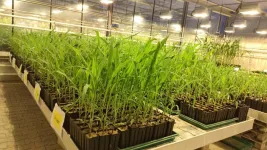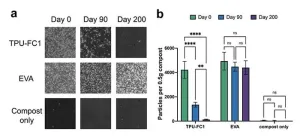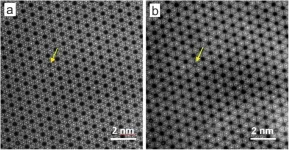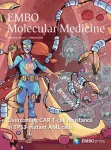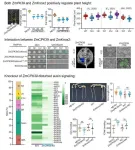(Press-News.org) Contact:
Jillian McKoy, jpmckoy@bu.edu
Michael Saunders, msaunder@bu.edu
##
Identifying genetic variants and the role they play in predisposing people to Alzheimer’s disease can help researchers better understand how to treat the neurodegenerative condition for which there is currently no cure. A new study led by Boston University School of Public Health (BUSPH) and UTHealth Houston School of Public Health has identified several genetic variants that may influence Alzheimer’s disease risk, putting researchers one step closer to uncovering biological pathways to target for future treatment and prevention.
Published in the journal Alzheimer’s & Dementia: The Journal of the Alzheimer's Association, the study utilized whole genome sequencing and identified 17 significant variants associated with Alzheimer’s disease in five genomic regions. This data enables researchers to pinpoint rare and important genes and variants, building upon genome-wide association studies, which focus only on common variants and regions.
The findings underscore the value of whole genome sequencing data in gaining long-sought insight into the ultimate causes and risk factors for Alzheimer’s disease, which is the fifth leading cause of death among people 65 and older in the United States. As the most common form of dementia, Alzheimer’s disease currently affects more than 6 million Americans and that number is expected to skyrocket to nearly 13 million by 2050.
“Prior genome-wide association studies using common variants have identified regions of the genome, and sometimes genes, that are associated with Alzheimer’s disease,” says study co-senior author Dr. Anita DeStefano, professor of biostatistics at BUSPH. “Whole genome sequence data interrogates every base pair in the human genome and can provide more information about which specific genetic change in a region may be contributing to Alzheimer’s disease risk or protection.”
For the study, the researchers conducted single variant association analyses and rare variant aggregation association tests using whole genome sequencing data from the Alzheimer’s Disease Sequencing Project (ADSP), a genetics initiative that the National Institutes of Health developed in 2012 as part of the National Alzheimer’s Project Act’s goal to treat and prevent the disease. The ADSP data include more than 95 million variants among 4,567 participants with or without the disease.
Among the 17 significant variants that were linked to Alzheimer’s disease, the KAT8 variant was one of the most notable, as it was associated with the disease in both the single and rare variant analyses. The researchers also found associations with several rare TREM2 variants.
“By using whole genome sequencing in a diverse sample, we were able to not only identify novel genetic variants associated with Alzheimer’s disease risk in known genetic regions, but also characterize whether the known and novel associations are shared across populations,” says study co-lead and corresponding author Dr. Chloé Sarnowski, assistant professor in the Department of Epidemiology at UTHealth Houston School of Public Health.
The ADSP includes ethnically diverse participants, and the population-specific assessments focused on White/European-ancestry, Black/African-American, and Hispanic/Latino subgroups, as well as a multi-population meta-analysis. Historically, Black and and Latino populations have been underrepresented in genetic studies of Alzheimer’s disease despite having a higher prevalence of the disease than other ethnic groups.
“Including participants that represent diverse genetic ancestry and diverse environments in terms of social determinants of health is important to understanding the full spectrum of Alzheimer’s disease risk, as both the prevalence of the disease and the frequencies of genetic variants can differ among populations,” says Dr. DeStefano. The sample sizes in the population-specific analyses were small, so the team had limited ability to detect associations, she says, “but we replicated known population differences for the APOE gene, which is one of the best-known and strongest risk genes for Alzheimer’s disease.”
In future studies, the researchers hope to examine the population-specific variants they identified in much larger sample sizes, as well as explore how these variants affect biological functioning.
“We are currently working on expanding this research to be able to use whole genome sequencing with larger sample sizes in the ADSP to be able to look at the full array of genetic variants, not only within known Alzheimer’s disease genetic regions, but across the whole genome,” says co-senior author Dr. Gina Peloso, associate professor of biostatistics at BUSPH.
The study was also co-led by Yanbing Wang while she was a PhD student in biostatistics at BUSPH. It was funded by the National Institute on Aging under Award Numbers U01 AG058589 and U01 AG068221.
**
About Boston University School of Public Health
Founded in 1976, Boston University School of Public Health is one of the top ten ranked schools of public health in the world. It offers master's- and doctoral-level education in public health. The faculty in six departments conduct policy-changing public health research around the world, with the mission of improving the health of populations—especially the disadvantaged, underserved, and vulnerable—locally and globally.
END
Researchers identify novel genetic variants associated with Alzheimer’s disease
A new study applied whole genome sequencing to pinpoint specific genes and genetic changes of interest in genetic regions previously associated with Alzheimer’s disease to inform future treatment and prevention strategies.
2024-03-21
ELSE PRESS RELEASES FROM THIS DATE:
Research team identifies genetic contribution to the composition of the microbiome around maize roots
2024-03-21
In order for plants to grow, they absorb water and nutrients through their roots. In doing so, they rely on tiny helpers: bacteria and fungi in particular are found in a thin layer around the roots. These microbes also ward off organisms that are harmful to the plant, just as the "microbiome" in the human gut helps determine whether we fall ill or stay healthy.
An international research team led by the University of Bonn and with the participation of the IPK Leibniz Institute has now demonstrated on maize plants that the genetic make-up of the host plant has a significant influence on the composition of the root microbes. "It was shown ...
Climate change disrupts vital ecosystems in the Alps
2024-03-21
Reduced snow cover and shifting vegetation patterns in the Alps, both driven by climate change, are having major combined impacts on biodiversity and functioning of ecosystems in the high mountains, according to new research published today.
Mountain ranges covering vast areas of the world are warming much faster than surrounding lowland areas, triggering huge reductions in snow cover and rapid upward movement of dwarf-shrubs, such as heather.
Scientists at The University of Manchester have found that these changes are disrupting the timing of crucial alpine ecosystem functions performed by ...
Say hello to biodegradable microplastics
2024-03-21
Microplastics are tiny, nearly indestructible fragments shed from everyday plastic products. As we learn more about microplastics, the news keeps getting worse. Already well-documented in our oceans and soil, we’re now discovering them in the unlikeliest of places: our arteries, lungs and even placentas. Microplastics can take anywhere from 100 to 1,000 years to break down and, in the meantime, our planet and bodies are becoming more polluted with these materials every day.
Finding viable alternatives to traditional petroleum-based plastics and microplastics has never been more important. New research from scientists ...
New method for analyzing nanoporous materials
2024-03-21
In addition to their main components, the properties of crystalline and nanoporous materials often depend crucially on guest atoms or ions that are embedded in the tiny pores of their lattice structure. This applies to high-tech materials used in sensor or separation technology as well as to natural materials. The bluish gemstone aquamarine, for example, would be colourless without such guest components. Determining the type and position of guest components is difficult, as many materials react sensitively to the radiation emissions ...
An immunotherapy to overcome resistant leukemia
2024-03-21
Acute myeloid leukemia (AML) is an aggressive form of blood cancer. It is caused by mutations in a large number of genes that are acquired in the course of a person’s life. One of these genes – the tumor suppressor gene TP53 – plays a key role. Normally, TP53 helps to prevent the development of tumors. Blood cancer patients in whom this gene is mutated, however, face an extremely poor prognosis, as their genes are resistant to conventional chemotherapeutic agents. Intensive research is therefore being carried out into new therapeutic approaches, ...
The irony of smoking to stay thin: smoking increases belly fat
2024-03-21
The worry of gaining weight is a common excuse for smokers not to quit. A new study published today in the scientific journal Addiction has found that both starting smoking and lifetime smoking may increase abdominal fat, especially visceral fat: the unhealthy fat deep inside the abdomen that is linked to a higher risk of heart disease, diabetes, stroke, and dementia.
Smokers tend to have lower body weights than non-smokers, but they also have more abdominal fat, and more abdominal visceral fat. Visceral fat is hard to see; you can have ...
Healing eyes with contact lenses
2024-03-21
A cross-disciplinary University of Waterloo team has developed a new contact lens material that could act as a bandage for corneal wounds while releasing drugs in a controlled manner to help the eye heal faster.
Typically, corneal abrasion patients spend seven to 10 days wearing a clear, oxygen-permeable bandage contact lens, often instilled with eyedrops containing antibiotics. However, the one-time antibiotic application makes it difficult to ensure enough drugs stay on the eye for sustained treatment.
“It’s a targeted-release drug delivery ...
Excess temperatures cause low flocking concerns
2024-03-21
High temperatures during critical periods of the reproductive cycle of sheep result in 2.1 million fewer lambs produced in Australia each year, costing sheep farmers an estimated $97 million annually.
The work, funded by Meat and Livestock Australia and conducted by a transdisciplinary team of researchers from the University of Adelaide and South Australian Research Development Institute (SARDI), found that days above 32°C during the week of mating caused the significant loss of potential lambs.
Published in Nature Food, the study found annual losses of potential lambs would increase to 2.5 million if median global warming increased ...
The maize ZmCPK39-ZmKnox2 module regulates plant height
2024-03-21
This study was led by Professor Mingliang Xu (College of Agronomy and Biotechnology, China Agricultural University, Beijing, China). Through phylogenic analysis, the authors identified a gene encoding a calcium-dependent protein kinase, ZmCPK39, as a candidate gene for plant height regulation in maize. The function of ZmCPK39 in controlling plant height has been verified using gene editing technology. Compared to the wild-type ND101, knockout of ZmCPK39 significantly reduced plant height by 40%.
The authors further ...
New route to recyclable polymers from plants
2024-03-21
Cellulose, abundantly available from plant biomass, can be converted into molecules used to make a new class of recyclable polymers, to sustainably replace some plastics.
Researchers at Hokkaido University have taken a significant step forward in the drive to make recyclable yet stable plastics from plant materials. This is a key requirement to reduce the burden of plastic pollution in the environment. They developed a convenient and versatile method to make a variety of polymers from chemicals derived from plant cellulose; crucially, these polymers can be fully recycled. The method was published in the journal ACS Macro Letters.
Cellulose is one of the most abundant ...
LAST 30 PRESS RELEASES:
Injectable breast ‘implant’ offers alternative to traditional surgeries
Neuroscientists devise formulas to measure multilingualism
New prostate cancer trial seeks to reduce toxicity without sacrificing efficacy
Geometry shapes life
A CRISPR screen reveals many previously unrecognized genes required for brain development and a new neurodevelopmental disorder
Hot flush treatment has anti-breast cancer activity, study finds
Securing AI systems against growing cybersecurity threats
Longest observation of an active solar region
Why nail-biting, procrastination and other self-sabotaging behaviors are rooted in survival instincts
Regional variations in mechanical properties of porcine leptomeninges
Artificial empathy in therapy and healthcare: advancements in interpersonal interaction technologies
Why some brains switch gears more efficiently than others
UVA’s Jundong Li wins ICDM’S 2025 Tao Li Award for data mining, machine learning
UVA’s low-power, high-performance computer power player Mircea Stan earns National Academy of Inventors fellowship
Not playing by the rules: USU researcher explores filamentous algae dynamics in rivers
Do our body clocks influence our risk of dementia?
Anthropologists offer new evidence of bipedalism in long-debated fossil discovery
Safer receipt paper from wood
Dosage-sensitive genes suggest no whole-genome duplications in ancestral angiosperm
First ancient human herpesvirus genomes document their deep history with humans
Why Some Bacteria Survive Antibiotics and How to Stop Them - New study reveals that bacteria can survive antibiotic treatment through two fundamentally different “shutdown modes”
UCLA study links scar healing to dangerous placenta condition
CHANGE-seq-BE finds off-target changes in the genome from base editors
The Journal of Nuclear Medicine Ahead-of-Print Tip Sheet: January 2, 2026
Delayed or absent first dose of measles, mumps, and rubella vaccination
Trends in US preterm birth rates by household income and race and ethnicity
Study identifies potential biomarker linked to progression and brain inflammation in multiple sclerosis
Many mothers in Norway do not show up for postnatal check-ups
Researchers want to find out why quick clay is so unstable
Superradiant spins show teamwork at the quantum scale
[Press-News.org] Researchers identify novel genetic variants associated with Alzheimer’s diseaseA new study applied whole genome sequencing to pinpoint specific genes and genetic changes of interest in genetic regions previously associated with Alzheimer’s disease to inform future treatment and prevention strategies.
